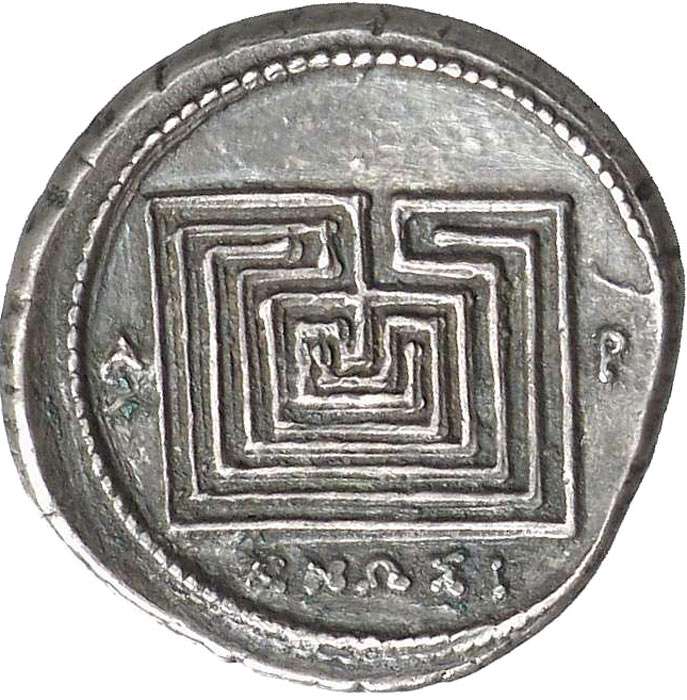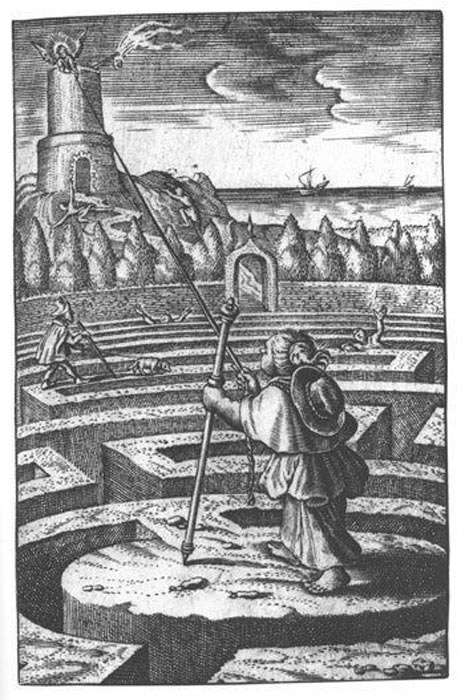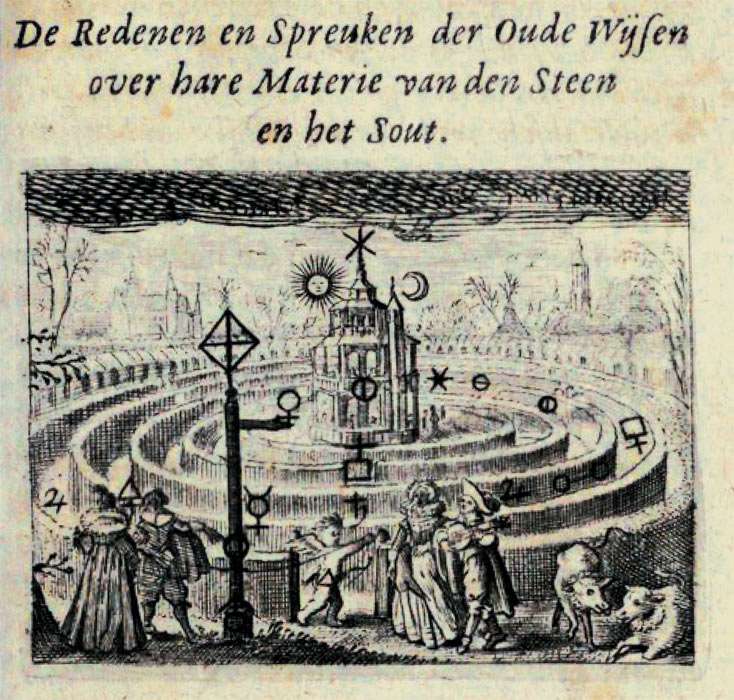|
In Greek mythology, the Labyrinth was an elaborate, confusing
structure designed and built by the legendary artificer Daedalus for
King Minos of Crete at Knossos. Its function was to hold the Minotaur,
creature half man and half bull. That monster was eventually killed by the
hero Theseus. Daedalus had so cunningly made the Labyrinth that he could
barely escape it himself after he had built it.
The Minotaur represents the animal instincts of man, which must be
overcome when on the spiritual path. Ariadne, King Minos' daughter, had fallen in
love with Theseus and, on the advice of Daedalus, gave him a ball of
thread, so he could find his way out of the Labyrinth.

Silver Drachm Coin From Knossos, ca. 300-270
BC, Münzkabinett der Staatlichen Museen, Berlin, Germany
The design above is just one example of a labyrinth. Labyrinths were
depicted in many different patterns.
Some alchemists used the idea of the labyrinth as a metaphor for the
often complicated and bewildering instructions in so many alchemical
texts.
Antoine-Joseph Pernety defines the labyrinth in his Dictionnaire
mytho-hermétique, 1758 as:
The Hermetic Philosophy which uses the fable of
Theseus and the Minotaur, took the opportunity of labyrinth of Crete to
embellish this story, and at the same time it indicates the difficulties
that arise in the operations of the Great Work, by those who want to get
out of the labyrinth when they got into it. One needs Ariadne's thread,
supplied by Daedalus himself, to succeed; that is to say that it is
necessary to be led and directed by a Philosopher who did the work
himself. This is what Morien assures us in his Interview with King Calid.
The labyrinth was a popular illustration in many religious texts, or
paintings, as in the following image:

Pia desideria, by Herman Hugo, 1628
This illustration is from an emblem book by the
Jesuit priest Herman Hugo. This is not an alchemical text, but it shows
that the religious interpretation of the labyrinth was well known in
western Europe. It shows Theseus as a pilgrim (the spiritual seeker) in
the middle of the labyrinth (the confusing world), holding the thread of
Ariadne (his soul) who is imprisoned in the tower (the physical body) by
her father the king (the ordinary personality).
This following illustration is from a Dutch alchemical book, The
Green Lion.

De Groene Leeuw, by Goossen van Vreeswijk,
1674, page 123
The figures in the front wear Spanish outfits, as the book was
published during the era of the Spanish Netherlands. To the right we
have a woman of aristocracy and a man playing a stringed instrument. To
the left, the pair represents Theseus with Ariadne, as there is a string
running from the woman to the putto at the entrance of the labyrinth. In
the middle of the labyrinth is a rotunda, with a a star on top and sun
and moon next to it, symbols for Salt (the body), Sol (the spirit) and
Luna (the soul).
The title above the illustration reads: The reasons and sayings
of the old wise men about their matter of the stone and the salt.
In the text below the illustration, the author writes:
"On page 9 in the Preface of the 12 Keys,
Basilius says that the seed is made out of the stone by the art as such:
It is not necessary to seek the seed in the Elements, because the
seed is not so far from us removed, and the place is nearby, where in
the same it has its home and tavern; and only in the 🜍 and 🜍,
and Salt, namely of the wise, and there is the fame to find. With
these words, he is pointing us the way to go..."
Goossen van Vreeswijk is explaining here that following the teachings
of the ancient adepts serves as the thread of Ariadne that will lead the
alchemist safely in and out the labyrinth of confusing texts, symbols
etc.
As alchemical manuscripts and books multiplied, it became more
confusing for an aspiring alchemist to understand the multitude of
symbols, allegories and descriptions. Thus, it became necessary to have
some kind of guidance, otherwise it was all too easy to give up. Joannes
Agricolae writes in his Treatise on Gold (17th
century) that all these texts were forming a labyrinth of confusion:
"Many a man may well write a process that is
clear enough to an experienced chymist, no matter how obscure it is. To
a beginner, however, it is not only of no use but rather confusing and
damaging - as some of our author's also are - and he gets so mixed up
with them that he can never get out of this labyrinth unless he obtains
an Ariadne's thread. That is why many are induced to abandon the
chymical works altogether, keeping only to the roving vagrants, and
giving the poor patients no matter what, exposing them to mortal danger
- and I know many of them."
Thomas Vaughan writes in his Lumen de Lumine, or a New
Magical Light (1651), about an allegorical vision in which he encounters
a beautiful lady, most likely Nature, about the need for the alchemist
to have thread of Ariadne, identifying Ariadne with the Light of Nature:
"These were her instructions, which were no
sooner delivered but she brought me to a clear, large light; and here I
saw those things which I must not speak of. Having thus discovered all
the parts of that glorious labyrinth, she did lead me out again with her
clue of sunbeams - her light that went shining before us."
|

